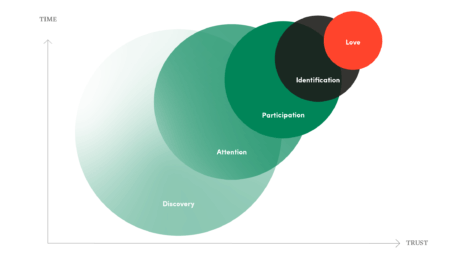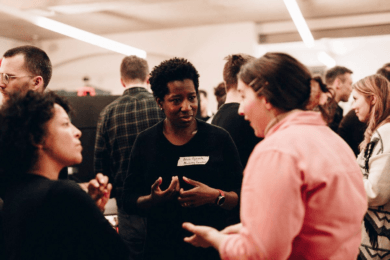What is community and how do you sustain it?
It was these fundamental questions that brought Severin Matusek and Kristoffer Tjalve together in 2017 to launch co-matter. Today, co-matter is a global network that examines the foundations of community, and how communities can be sustained across organizations, spaces and geographies. Based both in Copenhagen and Berlin, the team works with companies of all sizes to cultivate their community efforts and to explore methods of how culture, technology, and society bring people together.
co-matter is an outcome of Severin and Kristoffer's longtime desire to understand just what makes communities thrive. At the time of its founding, co-matter's co-founders were already longstanding figures of the European tech scene, with Severin running community initiatives at Berlin's EyeEm, and Kristoffer, working as an ecosystem builder behind institutions such as #BeTech, Mosaik, CPH:DOX and The Hive Brussels. Through their work, the pair experienced firsthand how important community and belonging could be when it came to building sustainable businesses, brands and grassroots initiatives. At the same time, they found that community formation was in continual change thanks to new technologies and digital tools. It was the desire to further explore the possibilities and challenges of community that brought the pair together to work on co-matter full time.
Today, co-matter has become a fixture of the European tech ecosystem and hosts regular Community Leadership Summits, a podcast, as well as an annual research publication, The State of Communities. I sat down with Kristoffer and Severin to learn a bit more about the 2019 State of Communities report and their work with co-matter.
Hi Kristoffer and Severin, thanks for joining us today on tech.eu! To get started, can you tell us a little bit about co-matter? Why do you think communities are so important, and what made you want to build co-matter?
Severin: We all have a universal desire to belong. That’s always been there. What’s new is that traditional structures of belonging, like families and religions, are getting replaced by more fluid communities that are virtual and interest-based. Commerce becomes a big part of it as more and more brands understand the value of community. And technology has enabled us to connect to anyone, anywhere. All of that is why I believe communities are part of a big change in the way we connect and build relationships. We’re only at the beginning.
Kristoffer: Communities are still a relatively new idea in the business world. Unfortunately, many brands still think of communities as social media management and customer service. Each are important, but labelling them community is reductive. Communities are some of the most resilient and meaningful social organisms we have. We started co-matter to explore how communities thrive - with and without commercial intent.
Kristoffer, you have been at the start of a number of community initiatives in the European tech ecosystem. For example, you founded The Hive in Brussels and also were part of the founding team that put together Belgium’s #BeTech. Can you tell us a little bit about these experiences and what you learned about community development from them?
Kristoffer: Traditionally we think value is attached to consumption. I only gain value from the coffee at the moment I drink it. Entire industries have been around optimizing the value chain to produce and sell for consumption.
With communities it is different. The value is often not in the consumption, but in the contribution. In both #BeTech and The Hive Brussels, those members who gained the most value out of the initiatives, were also those who contributed the most. Of course, not everyone has the time, resources or motivation to contribute equally, so it is important to create different levels of participation.
I believe this is the most fundamental learning from those two initiatives. However, I was actually thinking a lot about what I learned from both initiatives, so if anyone is interested you can read the Story Behind #BeTech and the Operational Manual for The Hive Brussels. It makes me smile that the first thing I share in the playbook is “Community First”.
Severin, before founding co-matter you were the VP of Community at EyeEm, which is famed for its enthusiastic community of photographers and art lovers. What were some of the biggest takeaways from this experience, and what made you want to apply these lessons to your work at co-matter?
Severin: Big question! I’m trying to sum it up in 3 key learnings: To begin with, we’ve always put community first and developed our product and business model in close cooperation with our core members. This is the ultimate ROI of investing into your community. I’m convinced we wouldn’t have succeeded otherwise. Second, when we started in 2011 there were tons of photo sharing apps that offered the same features. Because of everything we’ve done for and with the community - our exhibitions, festivals, competitions and print magazine - we built a strong brand that helped us differentiate from the rest. Today EyeEm is the only photo app from that generation that’s still going strong next to Instagram. Finally, I’ve met people around the world who discovered their passion for photography through EyeEm. People have changed careers, traveled the world, found their closest friends. Having been part of making that happen is the one thing I’m most proud of. It’s what still gets me excited to work with communities today.
co-matter works with some of the world’s top brands and organizations to support their community development. What, have you found, are some of the most integral aspects of community?
Kristoffer: In our State of Communities Report 2018, one of the key findings was that there often is a mismatch between why the company wants to create a community and why the members join: Where companies build communities to grow, members join communities to connect. It is very important for the community to meet both interests and we often see that it pays off spending time developing a strong, shared purpose.
Severin: If you’re brand or organization it’s important to start small. Many think that you can build a community of millions overnight. That obviously doesn’t work. When we work with brands we map out the journey it takes from first discovery to becoming a core member. We then develop formats to bring people from one stage to the next. A good example of that is the Stack Zero Grant Program we worked on with Samsung NEXT. It was the VC’s first step to connect with the decentralization ecosystem in a meaningful way. We’re now building on that foundation and develop Stack Zero further into an educational and mentorship program.

What can a strong community do for an organization?
Severin: It’s where you find the best talents and ideas. It influences your culture and your team. It helps you reach the people that are most relevant to your mission and values. Being in close touch with your community is crucial to staying relevant and being ahead of your competition.
Kristoffer: Today almost anything can be copied, from code and design, to business models and hardware. However, trust and relationships can’t be copied. If an organization is fortunate to have a strong community, it is a competitive advantage that is nearly impossible for other organizations to replicate.
What are some of the key challenges for keeping a community together? How do you know that a community is thriving, and when do you know that it needs an intervention?
Severin: When people stop engaging you know that something is wrong. It’s like you're riding a dead horse. Don’t ride a dead horse.
co-matter hosts regular events and a yearly Community Leadership Summit. As our lives are increasingly lived online, there is still an important role for bringing communities together in person. What are some of the things you do at the Community Leadership Summit, and what are the key takeaways?
Severin: We treat our Summits like research seminars. Every Summit has a different topic that we aim to explore in depth. Everyone who joins is a researcher. It’s serious and fun at the same time. In the end we have a communal dinner and drinks together. It’s all about connecting in real time, nothing can ever replace that.
Kristoffer: Ultimately, the Community Leadership Summit is about creating a regular space for peer-level conversations around the topics closest to our hearts and minds. Participants have to apply to get invited and we don’t accept anyone who we could not imagine being on stage. We don’t invite speakers, but source the talks from the people who apply to join the summit. Even talking about the stage is a bit odd, because the majority of the time at the summit is spent in smaller breakout sessions where we have facilitators to ensure everyone gets heard and the conversation keeps flowing.

Co-matter also has a podcast. Who do you invite on your programme, and what are some of the interesting things you’ve learned from them?
Severin: The podcast is our research medium where we try to invite a wide variety of people to share their perspectives. We had social media activists like Khalid Albaih talk about the Arab Spring, author Claire L. Evans tells the story of the first female community builders on the Internet, or Yousef Hammoudah share how he grew Adidas Runners into a global community. It gets quite philosophical and hands-on at the same time. Ultimately, we try to gather learnings of what community means in many different contexts, and provide community builders with new ideas to implement in their own practice.
Can you tell us a bit about the State of Communities Report? What are some of the things you hope to discover in this year’s edition?
Severin: The State of Communities is our annual survey where we aim to find out how people connect, engage and participate today and in the future. This year we focus a lot on social media. Our relationship to social media is evolving and we’re reconsidering its role in our lives. The findings we’ve got so far are quite perplexing...
How can people take part in this year’s State of Community Report?
Just go and fill it out here.
What is coming up next for you and co-matter?
Kristoffer: We’ve recently changed the landing page of our newsletter. Previously it was a classic ‘subscribe’ button, but now it is a short form asking people what they would like to contribute to the co-matter network. From the outside it seems like a small change, but for us it is an important step towards more explicitly thinking about co-matter as a network where everyone who is a part of the network contributes to the mission of creating more meaningful relationships across the globe.
Severin: Our next Summit is coming up on September 6, 2019 in Copenhagen. You should join!



Would you like to write the first comment?
Login to post comments